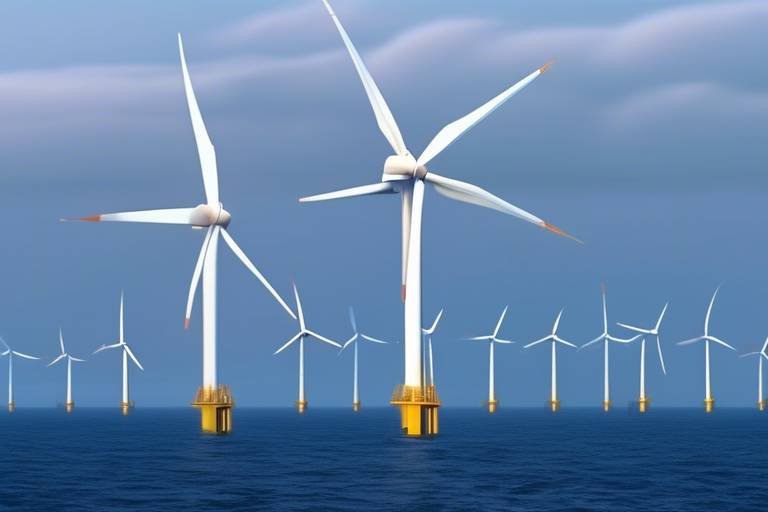Climate Change's Impact on Global Trade
Climate change is no longer just a looming threat; it’s a reality that is reshaping the very fabric of global trade. As we witness an increase in extreme weather events, rising sea levels, and unpredictable climate patterns, businesses and nations are being forced to rethink their strategies. The impact of climate change on trade is profound, affecting everything from supply chains to market dynamics. Have you ever considered how a drought in one part of the world could ripple through to affect the price of coffee in your local café? This article delves into the intricate ways climate change is altering global trade, emphasizing the urgency for adaptation and innovation.
As climate change intensifies, companies are beginning to realize that their traditional supply chains are vulnerable. Severe weather events like hurricanes, floods, and droughts can disrupt logistics and halt production. Businesses are now prioritizing the need for more resilient supply chains that can withstand these disruptions. For instance, a manufacturer might shift its sourcing from a flood-prone region to a more stable area, even if it means higher costs. This geographic shift is not just about avoiding disasters; it’s about ensuring that goods can reach consumers without interruption. In this new landscape, flexibility and adaptability are key. Companies are increasingly investing in technology and infrastructure to create smarter, more resilient logistics networks that can respond to the unpredictable nature of climate change.
The economic implications of climate change on global trade are staggering. Nations that rely heavily on climate-sensitive sectors, such as agriculture and tourism, are particularly vulnerable. As these industries face disruptions, the pricing of goods can fluctuate wildly, leading to market instability. For example, when a major coffee-producing country experiences a drought, the global coffee prices can skyrocket, affecting consumers worldwide. This volatility creates a challenging environment for businesses trying to maintain competitiveness. Countries that adapt quickly by diversifying their economies and investing in sustainable practices will likely emerge as leaders in the new global trade landscape. The question is, how can nations balance economic growth with environmental responsibility?
Agriculture is at the forefront of climate change's impact on global trade. With changing weather patterns, crop yields are becoming increasingly unpredictable. This unpredictability can disrupt traditional trade routes and force nations to seek alternative markets for their agricultural products. For instance, if a staple crop like wheat fails in one country, it may lead to increased imports from another, shifting trade dynamics significantly. Furthermore, the rising prices of food due to supply chain disruptions can lead to food insecurity, especially in vulnerable regions. This not only affects the local population but can also lead to international trade conflicts as nations scramble to secure food supplies.
As climate change alters weather patterns, the effects on crop yields are becoming evident. Farmers are facing challenges such as droughts, floods, and pest invasions, which can drastically reduce production. This decline in yields can disrupt traditional trade routes and necessitate a search for new markets. Countries that adapt by investing in resilient agricultural practices, such as drought-resistant crops, may find themselves at an advantage in the global market. The need for innovation in agriculture has never been more critical, as nations strive to maintain food security while navigating the complexities of international trade.
The link between climate change and food security is a pressing concern. As agricultural production becomes more erratic, the stability of food supplies is jeopardized. This instability can lead to trade conflicts, as countries prioritize their own food needs over international agreements. The potential for humanitarian crises looms large, especially in regions already facing economic hardships. Addressing these challenges requires a multi-faceted approach, including international cooperation and local adaptation strategies.
Manufacturing sectors are not immune to the challenges posed by climate change. Resource scarcity, driven by environmental degradation, can lead to increased operational costs for manufacturers. For instance, if water becomes scarce in a region, industries reliant on water for production may face significant hurdles, affecting their ability to compete globally. This shift can disrupt international trade flows and force companies to rethink their production strategies. Embracing sustainable practices and investing in green technologies will be essential for manufacturers aiming to thrive in an increasingly competitive landscape.
To combat the impacts of climate change on trade, governments worldwide are stepping up with policies aimed at fostering sustainability. Initiatives such as carbon pricing and international agreements are becoming more common as nations recognize the need for collective action. These policies not only aim to mitigate the adverse effects of climate change but also promote fair trade practices that benefit all nations. The challenge lies in ensuring that these policies are effectively implemented and that they address the unique needs of different countries.
International collaborations are crucial for creating frameworks that address climate change while promoting equitable trade practices. Agreements such as the Paris Accord aim to unite nations in the fight against climate change, ensuring that all countries can participate in sustainable economic development. As nations work together, the hope is to create a more resilient global economy that can withstand the shocks of climate change.
On a local level, governments are developing adaptation strategies to mitigate the effects of climate change on trade. This includes investing in infrastructure improvements and enhancing community resilience. By focusing on local needs and conditions, these strategies aim to support economic stability and ensure that communities can thrive even in the face of climate challenges. The path forward requires a concerted effort from all levels of government and the private sector to build a sustainable future.
- How does climate change affect global trade? Climate change impacts supply chains, pricing, and market access, leading to economic instability and challenges in food security.
- What are the main sectors affected by climate change? Agriculture and manufacturing are particularly vulnerable, facing disruptions due to weather extremes and resource scarcity.
- How can governments respond to these challenges? By implementing policies focused on sustainability, carbon pricing, and international cooperation to foster resilient trade practices.
- What role do international agreements play? They help create frameworks for nations to work together in addressing climate change while promoting fair trade.
- What can local governments do? They can develop adaptation strategies that focus on infrastructure improvements and community resilience to support economic stability.

Shifts in Supply Chains
Climate change is not just a distant threat; it’s a reality that businesses are grappling with right now. As the planet warms, extreme weather events like hurricanes, floods, and droughts have become more common, prompting companies to rethink their supply chains. Imagine a delicate web, intricately woven with various threads representing suppliers, manufacturers, and logistics providers. Now, picture that web being tugged and pulled in unexpected directions due to climate-related disruptions. This is the current scenario for many businesses worldwide.
To adapt to these changes, companies are exploring geographic shifts in their supply chains. For instance, firms that once relied on suppliers in areas prone to flooding might consider relocating to regions with more stable climates. This shift not only helps in reducing the risk of disruptions but also promotes resilience in logistics. Businesses are investing in technologies and strategies that improve their ability to respond to sudden changes, such as real-time tracking systems and diversified sourcing. The goal is to create a supply chain that can withstand the unpredictable nature of climate change.
Furthermore, the need for more resilient logistics is becoming increasingly apparent. Companies are recognizing that traditional supply chain models may no longer suffice in the face of climate change. For example, a company that ships goods via a single route might find itself at a standstill if that route is affected by a natural disaster. In response, businesses are adopting a more flexible approach by developing multiple shipping routes and alternative transportation methods. This adaptability is crucial in maintaining the flow of goods and services.
Moreover, the shift towards sustainable practices is gaining momentum. Many businesses are not just looking to relocate but are also focusing on environmentally friendly practices. This includes sourcing materials from sustainable suppliers, reducing carbon footprints, and investing in renewable energy sources. By doing so, companies not only mitigate the risks associated with climate change but also appeal to a growing consumer base that values sustainability. In this new landscape, being environmentally conscious is more than just a trend; it's becoming a necessity.
In summary, the shifts in supply chains driven by climate change are multifaceted. Companies are reevaluating their operations to enhance resilience, diversify their logistics, and embrace sustainability. As these changes unfold, the global trade landscape will continue to evolve, pushing businesses to innovate and adapt in ways we are only beginning to understand.

Economic Implications
This article explores how climate change affects global trade dynamics, including shifts in supply chains, economic implications, and the role of policy in mitigating adverse effects on international commerce.
Climate change is prompting businesses to reevaluate their supply chains, leading to geographic shifts and the need for more resilient logistics to withstand extreme weather events and disruptions.
The economic repercussions of climate change on global trade are significant, influencing pricing, market access, and competitiveness among nations, particularly those heavily reliant on climate-sensitive industries. As natural disasters become more frequent and intense, the costs associated with recovery and adaptation are skyrocketing. For instance, businesses may find themselves facing unexpected expenses related to infrastructure repairs, increased insurance premiums, and supply chain interruptions. This creates a ripple effect, impacting everything from the price of goods to the availability of products in the market.
Moreover, countries that depend on exports of climate-sensitive commodities, such as agricultural products and raw materials, are particularly vulnerable. A sudden drought or flood can devastate crop yields, leading to shortages that drive prices up. In turn, this can create tension between nations as they scramble to secure resources. The economic implications extend beyond immediate financial concerns; they can also lead to long-term shifts in trade relationships. Countries may need to seek new trading partners or invest in alternative products, altering the landscape of global commerce.
To illustrate the economic impact, consider the following table, which outlines how climate change can affect various sectors:
| Sector | Impact of Climate Change | Economic Consequences |
|---|---|---|
| Agriculture | Altered crop yields due to extreme weather | Increased food prices and potential trade conflicts |
| Manufacturing | Resource scarcity and increased operational costs | Reduced competitiveness and disrupted trade flows |
| Energy | Increased demand for renewable sources | Investment shifts and changes in market dynamics |
As global trade continues to evolve, nations will need to adapt their strategies to remain competitive. The key to thriving in this changing landscape lies in innovation and sustainability. Businesses that prioritize eco-friendly practices are likely to gain a competitive edge, as consumers become more environmentally conscious. This shift in consumer behavior can also open up new markets for green products, further reshaping the economic implications of climate change.
Agricultural production is highly susceptible to climate change, affecting food supply chains and trade patterns, leading to increased prices and food insecurity in vulnerable regions.
Changing weather patterns are altering crop yields, which can disrupt traditional trade routes and require nations to adapt by seeking alternative markets for their agricultural products.
The interconnection between climate change and food security raises concerns about the stability of food supplies, leading to potential trade conflicts and humanitarian crises.
Manufacturing sectors face challenges from climate change, including resource scarcity and increased operational costs, which can hinder global competitiveness and disrupt international trade flows.
Governments worldwide are implementing policies to address climate change impacts on trade, focusing on sustainability, carbon pricing, and international agreements to foster resilient trade practices.
International collaborations are essential to create frameworks that address climate change while promoting fair trade practices, ensuring that all nations can participate in sustainable economic development.
Local governments are developing adaptation strategies to mitigate the effects of climate change on trade, focusing on infrastructure improvements and community resilience to support economic stability.
- How does climate change affect global trade?
Climate change impacts global trade by altering supply chains, increasing costs, and affecting the availability of resources, leading to economic repercussions across various sectors. - What sectors are most affected by climate change?
Agriculture and manufacturing are particularly vulnerable due to their reliance on stable weather patterns and resources. - What can governments do to address these impacts?
Governments can implement policies focused on sustainability, invest in infrastructure, and participate in international agreements to create a resilient trade environment.

Impact on Agriculture
Climate change is not just a buzzword; it’s a reality that’s reshaping our world, and agriculture is feeling the heat—literally! As temperatures rise and weather patterns become increasingly erratic, farmers are facing unprecedented challenges. The very fabric of agricultural production is woven tightly with the climate, and any disruptions can lead to significant repercussions not just locally, but globally. Imagine a world where staple crops like wheat, rice, and corn are no longer reliable sources of food. This isn't just a nightmare scenario; it's a potential reality driven by climate change.
The impact on agriculture is multi-faceted. For one, changing weather patterns are altering crop yields. In regions where crops once thrived, farmers are now struggling to maintain productivity. This is not merely an inconvenience; it can lead to a domino effect on food supply chains. For instance, countries that traditionally export large quantities of grain may find their harvests dwindling, forcing them to seek alternative markets or even import food to meet domestic needs. This shift can lead to increased prices and food insecurity, particularly in vulnerable regions that rely heavily on imports.
Moreover, the interconnection between climate change and food security raises serious concerns. As agricultural output fluctuates, so does the stability of food supplies. This instability can lead to conflicts over resources, as nations scramble to secure their food sources. A prime example is the recent droughts in various parts of the world, which have not only affected local farmers but also triggered spikes in global food prices. The question arises: how can we ensure that everyone has access to food in a world where climate change is making it increasingly unpredictable?
To visualize the impact of climate change on crop yields, consider the following table:
| Crop Type | Projected Yield Change (%) by 2050 | Regions Most Affected |
|---|---|---|
| Wheat | -6% to -20% | North America, Europe, Asia |
| Rice | -10% to -30% | Asia, Africa |
| Corn | -8% to -25% | North America, South America |
This table highlights just how severe the potential impacts can be on key crops that feed billions. As yields decline, the ripple effects extend far beyond the farm gate. Countries that are heavily reliant on agriculture for their economies may find themselves in dire situations, leading to increased poverty and social unrest. The question of food security is no longer just an agricultural issue; it’s a pressing global concern that requires immediate attention and action.
In conclusion, the impact of climate change on agriculture is profound and far-reaching. As we navigate this new landscape, it’s crucial for policymakers, farmers, and consumers alike to understand the stakes involved. By prioritizing sustainable practices and investing in climate-resilient crops, we can work towards mitigating these effects and securing food for future generations. Are we ready to take the necessary steps to protect our food systems, or will we continue to gamble with our future?
- How does climate change affect crop yields? Climate change can lead to extreme weather conditions, such as droughts and floods, which adversely affect crop growth and yield.
- What are the economic implications of reduced agricultural output? Reduced agricultural output can lead to higher food prices, increased food insecurity, and economic instability, especially in countries dependent on agriculture.
- Can sustainable farming practices help mitigate climate change? Yes, implementing sustainable farming practices can improve resilience to climate change and help reduce its impacts on agriculture.

Crop Yields and Trade
The relationship between crop yields and trade is becoming increasingly complex as climate change continues to alter the agricultural landscape. In recent years, we have witnessed how unpredictable weather patterns, such as prolonged droughts or unexpected floods, can drastically reduce crop production. These fluctuations not only impact local farmers but also ripple through the global market, affecting trade dynamics. For instance, when a major agricultural exporter faces a significant drop in yield, it can lead to a surge in prices on the international market, forcing countries that rely on imports to scramble for alternative sources. This scenario illustrates how interconnected our food systems are and how vulnerable they can be to environmental changes.
Moreover, the need for nations to adapt to these changing conditions has become paramount. Countries are now investing in agricultural innovation and sustainable practices to mitigate the risks associated with climate change. This includes developing drought-resistant crop varieties, implementing advanced irrigation techniques, and employing precision farming methods. Such adaptations are not merely reactive; they are essential for maintaining competitive trade positions in a world where agricultural output is increasingly unpredictable. The shift towards more resilient agricultural practices can also lead to new trade opportunities, as nations that successfully innovate may find themselves better positioned in the global marketplace.
As we navigate these changes, it's important to consider the broader implications for food security. In regions where agriculture is a primary economic driver, declines in crop yields can lead to heightened food insecurity and social unrest. Countries heavily dependent on a single crop may find themselves particularly vulnerable to market fluctuations, prompting them to diversify their agricultural portfolios. This diversification can help stabilize local economies while also creating new trade routes and partnerships. For example, a country that traditionally exported only wheat may begin to explore the export of other grains or legumes, thereby reducing its risk and enhancing its trade resilience.
In light of these challenges, understanding the interplay between crop yields and trade is crucial. It requires a collaborative effort among governments, farmers, and international organizations to develop strategies that promote sustainability and resilience. As we look to the future, the question remains: how can we ensure that our global food systems remain robust in the face of climate change? The answer lies in innovation, cooperation, and a commitment to sustainable practices that can withstand the test of time.
- How does climate change affect crop yields? Climate change leads to unpredictable weather patterns, which can cause droughts or floods, significantly impacting crop production.
- What are some ways countries are adapting to changes in crop yields? Countries are investing in agricultural innovations, such as drought-resistant crops and advanced irrigation techniques, to mitigate risks.
- Why is crop yield variability a concern for global trade? Variability in crop yields can lead to price surges and supply shortages, affecting countries that rely on imports and destabilizing markets.
- How can nations ensure food security amidst climate challenges? By diversifying agricultural production and developing sustainable practices, nations can reduce vulnerability and create more resilient food systems.

Food Security Challenges
The interconnection between climate change and food security is a pressing issue that affects millions of people around the globe. As weather patterns become increasingly unpredictable, we face a scenario where agricultural output is compromised, leading to potential food shortages. This situation is not just a minor inconvenience; it poses a serious threat to global stability. When nations struggle to feed their populations, the consequences can ripple through international trade, leading to conflicts and humanitarian crises.
For instance, consider how rising temperatures and erratic rainfall patterns can drastically alter the landscape of food production. Farmers who once relied on consistent weather patterns now find themselves at the mercy of nature's whims. This unpredictability can lead to lower crop yields, which in turn affects the availability of food in local markets. Countries that are heavily dependent on agriculture for their economic stability may find themselves in a precarious position, as they grapple with the dual challenges of maintaining food supply and navigating the complexities of international trade.
Moreover, as food becomes scarcer, prices are likely to rise. This inflation can exacerbate existing inequalities, particularly in vulnerable regions where communities already struggle to access basic necessities. The impact on food prices can lead to increased tension among nations, especially those that rely on imports to meet their food demands. Countries may resort to protectionist measures, restricting exports to safeguard their own populations, which can trigger a domino effect in global trade.
To illustrate the potential fallout from these challenges, let's look at a few critical aspects:
| Challenge | Impact | Possible Solutions |
|---|---|---|
| Crop Failures | Reduced food availability and increased prices | Investment in resilient crop varieties |
| Resource Scarcity | Increased competition for water and arable land | Efficient resource management and conservation practices |
| Trade Conflicts | Heightened tensions between food-importing and exporting nations | International cooperation and fair trade agreements |
As we navigate these challenges, it becomes crucial for governments, organizations, and communities to work together. Implementing sustainable agricultural practices and investing in technologies that enhance food production resilience can help mitigate some of the adverse effects of climate change. Additionally, fostering international dialogue can pave the way for collaborative solutions that prioritize food security while promoting fair trade.
- How does climate change directly affect food security?
Climate change leads to unpredictable weather patterns, which can result in crop failures and food shortages. - What are the economic implications of food insecurity?
Food insecurity can drive up prices, leading to inflation and increased tension among nations reliant on food imports. - What solutions exist to combat food security challenges?
Solutions include investing in resilient crop varieties, improving resource management, and fostering international cooperation.

Impact on Manufacturing
Climate change is more than just a buzzword; it’s a reality that’s reshaping the manufacturing landscape in profound ways. As temperatures rise and extreme weather events become more frequent, manufacturers are finding themselves at a crossroads. They must either adapt to these changes or risk falling behind. One of the most pressing challenges is resource scarcity. As natural resources become depleted or more difficult to access due to environmental changes, manufacturers are forced to rethink their sourcing strategies. This not only affects the availability of raw materials but also impacts production costs, ultimately leading to increased prices for consumers.
Moreover, the operational costs of manufacturing are on the rise. Companies are increasingly investing in green technologies and sustainable practices to minimize their environmental impact. While this is a step in the right direction, it often comes with a hefty price tag. For instance, transitioning to renewable energy sources or implementing waste reduction systems requires significant upfront investment. As a result, manufacturers may find it challenging to maintain their competitive edge in the global market, especially when competing against firms in countries with less stringent environmental regulations.
The ripple effects of these challenges extend beyond individual manufacturers. The entire supply chain is affected, leading to disruptions in international trade flows. For example, consider a scenario where a factory in a coastal region is hit by a hurricane. Not only does this halt production, but it also affects the delivery of goods to retailers around the world. In such instances, manufacturers may need to seek alternative suppliers or markets, which can be a time-consuming and costly process.
In light of these challenges, many manufacturers are looking toward innovation as a solution. By embracing new technologies, such as automation and artificial intelligence, they can enhance efficiency and reduce waste. Furthermore, manufacturers are increasingly adopting circular economy principles, which emphasize reusing and recycling materials to minimize resource consumption. This shift not only helps in reducing the environmental footprint but also creates new opportunities for economic growth.
To illustrate the impact of climate change on manufacturing, let’s take a look at some key statistics in the table below:
| Challenge | Impact on Manufacturing | Potential Solutions |
|---|---|---|
| Resource Scarcity | Increased production costs due to limited raw materials | Sourcing alternative materials, recycling |
| Operational Costs | Higher expenses from adopting green technologies | Investing in energy-efficient processes |
| Supply Chain Disruptions | Delays in production and delivery | Diversifying suppliers, building resilient logistics |
| Innovation Needs | Pressure to enhance efficiency and sustainability | Adopting automation, circular economy practices |
In conclusion, the impact of climate change on manufacturing is vast and multifaceted. As manufacturers navigate this new reality, they must remain agile and proactive in their strategies. The path forward may not be easy, but by embracing innovation and sustainability, manufacturers can not only survive but thrive in a world that is constantly changing.
- How does climate change affect manufacturing costs?
Climate change can lead to increased operational costs due to resource scarcity and the need for sustainable practices, which often require significant investment.
- What are some solutions manufacturers are implementing to combat climate change?
Manufacturers are adopting green technologies, enhancing efficiency through automation, and implementing circular economy principles to minimize waste.
- Can climate change disrupt global supply chains?
Yes, extreme weather events and resource shortages can lead to significant disruptions in supply chains, affecting production and delivery timelines.

Policy Responses
As the effects of climate change become increasingly evident, governments around the world are stepping up to the plate with a variety of . These policies are not just about mitigating the immediate impacts on trade; they aim to create a sustainable framework that can adapt to the ongoing challenges posed by a changing climate. It's like trying to build a sandcastle while the tide is coming in—you need a solid foundation and a flexible approach to withstand the waves.
One of the most critical areas of focus is sustainability. Policymakers are recognizing that sustainable practices not only help the environment but also enhance economic resilience. For example, countries are promoting green technologies and renewable energy sources, which can reduce dependency on fossil fuels and lower greenhouse gas emissions. This shift is essential for maintaining competitive advantages in a world that is increasingly valuing sustainability in trade relationships.
Another significant aspect is the implementation of carbon pricing. This economic strategy aims to hold businesses accountable for their carbon emissions by assigning a cost to them. By doing so, it encourages companies to adopt cleaner technologies and practices. Think of it as a toll on the highway of production; the more pollution you create, the higher the toll you pay. This approach not only incentivizes businesses to innovate but also generates revenue for governments to invest in climate adaptation and mitigation efforts.
Moreover, international agreements play a pivotal role in shaping how countries respond to climate change. Global pacts like the Paris Agreement are essential in setting targets for emissions reductions and fostering collaboration among nations. These agreements help create a level playing field, allowing all countries to participate in sustainable economic development. Without such frameworks, the risk of trade conflicts and imbalances rises, as nations may be tempted to prioritize short-term gains over long-term sustainability.
Local adaptation strategies are also gaining traction as governments recognize that the effects of climate change are not uniform. Different regions face unique challenges, and thus, tailored solutions are necessary. Local governments are investing in infrastructure improvements to enhance resilience against extreme weather events. This can include upgrading transportation networks to withstand flooding, enhancing water management systems, and ensuring that communities have access to necessary resources during crises. It's about building a safety net that catches everyone, not just a select few.
In summary, the policy responses to climate change are multifaceted and require cooperation at all levels—local, national, and international. The road ahead is challenging, but with the right strategies in place, we can navigate the stormy seas of climate change and protect global trade for future generations.
- What are the main goals of climate change policies related to trade? The primary goals include promoting sustainability, reducing emissions, and fostering international cooperation to ensure fair trade practices.
- How does carbon pricing affect global trade? Carbon pricing holds businesses accountable for their emissions, encouraging them to adopt cleaner technologies, which can enhance competitiveness in a low-carbon economy.
- Why are international agreements important for trade? They establish common goals and standards, helping to prevent trade conflicts and ensuring that all countries can participate in sustainable economic development.
- What role do local governments play in climate adaptation? Local governments develop tailored strategies to enhance community resilience, invest in infrastructure improvements, and ensure that local economies can withstand climate impacts.

International Agreements
International agreements play a crucial role in addressing the multifaceted challenges posed by climate change on global trade. As nations grapple with the reality of a warming planet, the need for cooperative frameworks has never been more urgent. These agreements are not just diplomatic niceties; they represent a commitment to sustainable practices that can help mitigate the adverse effects of climate change on trade dynamics.
One of the most significant international agreements is the Paris Agreement, which aims to limit global warming to well below 2 degrees Celsius. This accord encourages countries to set their own targets for reducing greenhouse gas emissions, fostering a sense of responsibility and accountability. By aligning national policies with global goals, countries can work together to create a more stable trade environment. The agreement also emphasizes the importance of financial and technical support for developing nations, which often bear the brunt of climate impacts despite contributing the least to the problem.
Moreover, trade agreements increasingly incorporate environmental standards, making it essential for countries to adhere to sustainable practices. For instance, the Comprehensive and Progressive Agreement for Trans-Pacific Partnership (CPTPP) includes provisions that promote sustainable development and environmental protection. This reflects a growing recognition that trade and environmental policies are interconnected. By embedding climate considerations into trade agreements, countries can ensure that economic growth does not come at the expense of environmental degradation.
While these international agreements are steps in the right direction, their effectiveness often hinges on the commitment and cooperation of participating nations. To illustrate this point, consider the following table that outlines key international agreements and their primary focus areas:
| Agreement | Year Established | Primary Focus |
|---|---|---|
| Paris Agreement | 2015 | Global warming mitigation |
| CPTPP | 2018 | Trade liberalization and environmental standards |
| Kyoto Protocol | 1997 | Greenhouse gas emissions reduction |
In addition to these formal agreements, there are also numerous bilateral and multilateral initiatives aimed at fostering sustainable trade practices. These collaborations can take various forms, from joint research projects to technology transfers that help countries adapt to climate change. The exchange of knowledge and resources is vital, especially for developing nations that may lack the capacity to implement effective climate strategies on their own.
Ultimately, the success of international agreements in mitigating climate change's impact on trade depends on the ability of countries to work together toward common goals. As the effects of climate change become increasingly apparent, it is imperative that nations prioritize collaboration over competition. By doing so, they can create a resilient global trade system that not only withstands environmental shocks but also promotes sustainable economic development for all.
- What is the Paris Agreement? The Paris Agreement is an international treaty aimed at combating climate change by limiting global warming to well below 2 degrees Celsius.
- How do international agreements impact trade? International agreements can set standards for environmental practices in trade, helping to create a more sustainable and stable trading environment.
- What role do developing countries play in these agreements? Developing countries are often the most affected by climate change, and international agreements provide them with support and resources to adapt and mitigate impacts.

Local Adaptation Strategies
As the effects of climate change become increasingly evident, local governments are stepping up to the plate with adaptation strategies designed to mitigate potential disruptions in trade and ensure economic stability. These strategies are not just reactive measures; they are proactive plans aimed at building resilience within communities. Imagine a city that has faced repeated flooding; instead of waiting for the next disaster, local authorities might invest in enhancing drainage systems or creating green spaces that absorb excess water. This isn't just about protecting infrastructure; it's about safeguarding livelihoods and ensuring that trade routes remain operational.
One of the most effective strategies involves investing in infrastructure improvements. This can include upgrading roads, ports, and transportation networks to withstand extreme weather events. For instance, coastal cities may need to reinforce their ports to handle rising sea levels and stronger storms. By doing so, they not only protect their trade routes but also attract businesses looking for stable environments. Additionally, enhancing digital infrastructure can facilitate smoother logistics and communication, which are crucial in a rapidly changing global market.
Moreover, local governments are increasingly focusing on community resilience. This means engaging with local populations to develop strategies that reflect their unique challenges and strengths. For example, farmers may receive training on sustainable practices that not only improve crop yields but also reduce their vulnerability to climate-related shocks. By fostering a sense of community and encouraging collaboration, local adaptation strategies can lead to innovative solutions that benefit everyone.
Another critical aspect of these strategies is the integration of sustainability practices into local economies. This can involve promoting renewable energy sources, such as solar or wind power, which not only reduce carbon footprints but also create new job opportunities. By transitioning to a more sustainable economy, communities can enhance their resilience against the unpredictable impacts of climate change while also improving their competitive edge in global markets.
In summary, local adaptation strategies are crucial for mitigating the impacts of climate change on trade. By focusing on infrastructure improvements, community resilience, and sustainability, local governments can create a robust framework that supports economic stability and fosters a thriving trade environment. The future of global trade may very well depend on how effectively local entities can adapt to the challenges posed by our changing climate.
- What are local adaptation strategies? Local adaptation strategies are plans developed by local governments to mitigate the impacts of climate change, focusing on improving infrastructure, community resilience, and sustainable practices.
- Why are local adaptation strategies important for trade? They help ensure that trade routes remain operational and that local economies can withstand climate-related disruptions, ultimately supporting global trade stability.
- How can communities engage in adaptation strategies? Communities can participate by providing input on local challenges, collaborating with local governments, and adopting sustainable practices in their daily lives.
Frequently Asked Questions
- How does climate change affect global trade?
Climate change impacts global trade by disrupting supply chains, altering agricultural production, and creating economic challenges. Businesses are forced to adapt to extreme weather events, which can lead to geographic shifts in production and logistics. This results in increased costs and potential shortages in various markets.
- What are the shifts in supply chains due to climate change?
As climate change intensifies, companies are reevaluating their supply chains to enhance resilience. This might mean relocating production facilities to less vulnerable areas or investing in technologies that can withstand extreme weather. The goal is to ensure that logistics remain smooth and efficient despite environmental challenges.
- What economic implications does climate change have on trade?
The economic repercussions of climate change are profound. It can lead to fluctuating prices, hinder market access, and affect the competitiveness of nations, especially those dependent on climate-sensitive industries like agriculture and fishing. Countries may find themselves needing to adapt their economic strategies to cope with these changes.
- How is agriculture impacted by climate change?
Agriculture is particularly vulnerable to climate change, resulting in altered crop yields and food supply chain disruptions. This can lead to increased food prices and insecurity, especially in regions that are already fragile. Farmers may need to seek alternative markets or crops that can thrive under changing conditions.
- What challenges does climate change pose to food security?
The relationship between climate change and food security is critical. As weather patterns shift, food supplies can become unstable, leading to potential trade conflicts and humanitarian crises. Ensuring a stable food supply in the face of climate change is a pressing concern for many nations.
- How does climate change affect manufacturing sectors?
Manufacturing industries face significant challenges due to climate change, including resource scarcity and rising operational costs. These factors can hinder global competitiveness and disrupt trade flows, forcing manufacturers to innovate and adapt to maintain their market positions.
- What policies are being implemented to address climate change in trade?
Governments worldwide are developing policies focused on sustainability, carbon pricing, and international agreements to mitigate climate change impacts on trade. These policies aim to foster resilient trade practices that can withstand environmental changes while promoting economic stability.
- What role do international agreements play in trade and climate change?
International agreements are essential for creating frameworks that address climate change while promoting fair trade practices. By collaborating, nations can ensure that all countries participate in sustainable economic development, benefiting both the environment and global commerce.
- How are local governments adapting to climate change's effects on trade?
Local governments are developing adaptation strategies to mitigate climate change's impact on trade. This includes improving infrastructure and enhancing community resilience, which are crucial for maintaining economic stability and supporting local industries in the face of environmental challenges.



















